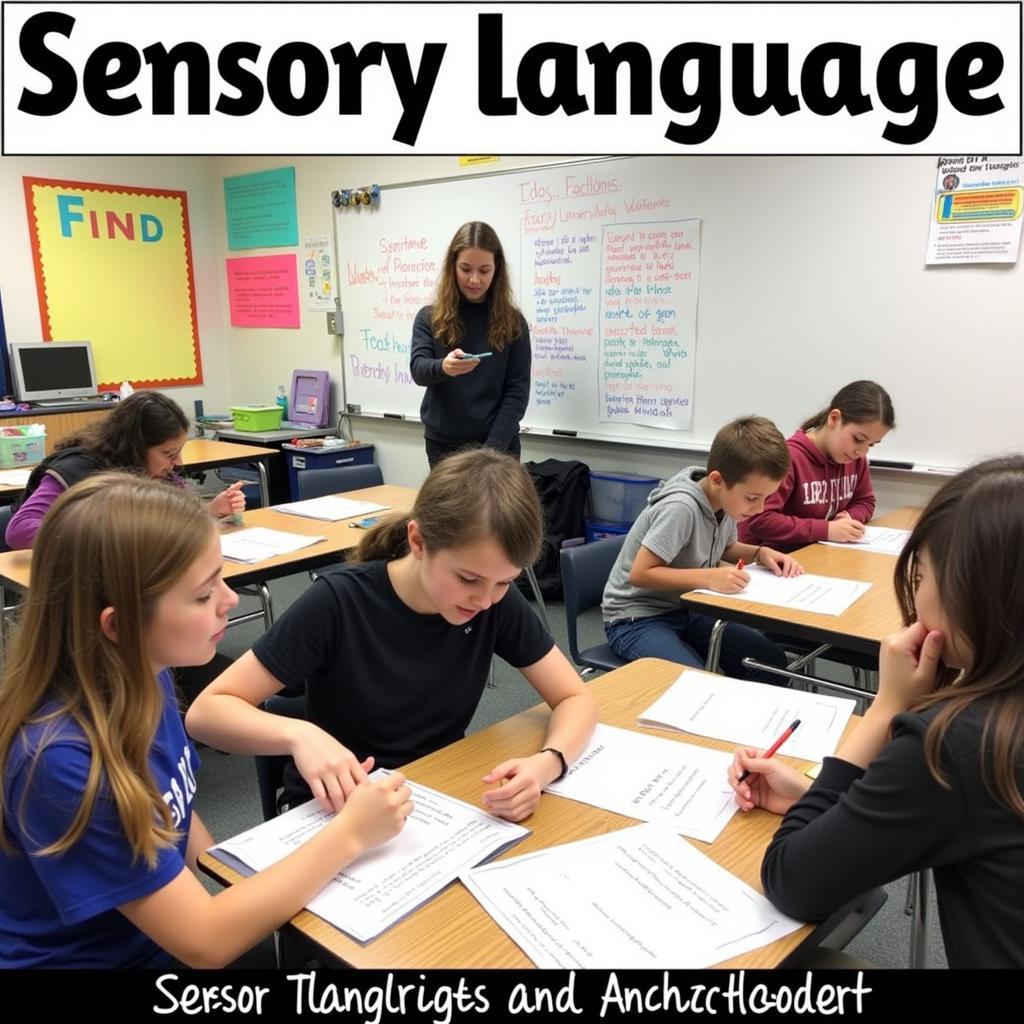Sensory Language Anchor Chart: A Comprehensive Guide
December 4, 2024Sensory Language Anchor Charts are essential tools for aspiring writers, helping them understand and utilize descriptive language to bring their writing to life. They provide a visual framework for incorporating sensory details—sight, sound, smell, taste, and touch—into written work, making it more engaging and immersive for the reader.
Understanding the Power of Sensory Language
Sensory details enrich writing by appealing to a reader’s senses. Imagine reading a story about a bustling marketplace. Without sensory language, the description might be limited to “a busy market.” But with sensory language, the scene transforms: “The marketplace buzzed with activity, a symphony of hawkers’ calls and the clatter of wooden carts. The air hung thick with the scent of exotic spices and ripe fruits, while brightly colored silks shimmered under the midday sun.” The added details create a vivid picture and transport the reader directly into the scene.
Creating an Effective Sensory Language Anchor Chart
A well-designed sensory language anchor chart serves as a quick reference point for students. It typically features five sections, one for each sense. Each section provides examples of words and phrases related to that specific sense. For sight, you might include words like “gleaming,” “vibrant,” or “shadowy.” For sound, you might include “crackle,” “whisper,” or “roar.”
Engaging all Five Senses in Your Writing
While using all five senses isn’t always necessary, striving for a balance can significantly enhance your writing. Consider the context and choose the senses that are most relevant and impactful. For example, describing a character’s fear might involve the pounding of their heart (touch), shallow breaths (sound), and a metallic taste in their mouth (taste).
Using Sensory Language in Different Genres
Sensory language isn’t limited to creative writing. It can also be used effectively in other genres, such as persuasive writing or informational texts. In persuasive writing, sensory details can evoke emotions and create a stronger connection with the audience. In informational texts, they can make complex concepts more concrete and relatable.
Incorporating Sensory Language Anchor Charts into the Classroom
Sensory language anchor charts can be used in various classroom activities. Students can create their own charts, brainstorm sensory details for specific scenarios, or analyze existing texts and identify the use of sensory language. They can also use the chart as a reference while writing their own stories, poems, or essays.
 Classroom Activities using Sensory Language Anchor Charts
Classroom Activities using Sensory Language Anchor Charts
Beyond the Basics: Advanced Sensory Language Techniques
Once students grasp the fundamentals, they can explore more sophisticated techniques, like using figurative language (similes, metaphors, personification) to enhance their sensory descriptions. For instance, instead of simply stating “the sun was hot,” they could write “the sun beat down like a fiery hammer.”
Sensory Language and Character Development
Sensory language can also be used to reveal character traits and motivations. A character who constantly notices unpleasant smells might be portrayed as fastidious or critical. A character who relishes rich and decadent foods might be depicted as indulgent or sensual.
Conclusion: The Impact of Sensory Language
Sensory language anchor charts provide a valuable foundation for developing strong writing skills. By mastering the art of incorporating sensory details, writers can create vivid and engaging pieces that capture the reader’s imagination and leave a lasting impression. Utilizing a sensory language anchor chart helps writers of all levels elevate their craft and bring their words to life.
FAQs
-
What is a sensory language anchor chart?
A sensory language anchor chart is a visual aid that provides examples of words and phrases related to the five senses. -
Why is sensory language important in writing?
Sensory language helps to create vivid and engaging writing by appealing to the reader’s senses. -
How can I use a sensory language anchor chart in the classroom?
Sensory language anchor charts can be used for brainstorming, analyzing texts, and as a reference during writing activities. -
How can I incorporate sensory language into different writing genres?
Sensory language can be used in all genres, from creative writing to persuasive writing and informational texts. -
What are some advanced sensory language techniques?
Figurative language, such as similes, metaphors, and personification, can enhance sensory descriptions. -
How can sensory language be used for character development?
Sensory language can reveal character traits and motivations by highlighting what they notice and how they react to sensory stimuli. -
How can I make my sensory language more impactful?
Focus on using specific and evocative words and phrases that create strong imagery and emotional responses.
Need More Help?
For further assistance or inquiries, please contact us:
Phone: 0963418788
Email: [email protected]
Address: 2M4H+PMH, Phường Nghĩa Thành, Gia Nghĩa, Đắk Nông, Việt Nam.
Our customer service team is available 24/7.